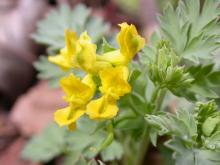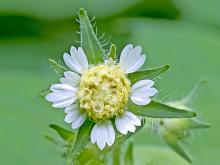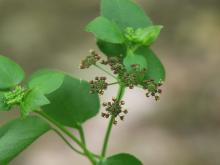Wildflowers, Grasses and Other Nonwoody Plants
Media

Species Types
Scientific Name
Securigera varia (formerly Coronilla varia)
Description
In summer, you’re almost guaranteed to see big colonies of crown vetch along Missouri's highways. This weedy nonnative plant stabilizes the dirt after road construction but degrades our natural ecosystems.
Media

Species Types
Scientific Name
Medicago lupulina
Description
The small, cloverlike flowering heads and trifoliate leaves of black medick are clues that this plant is in the Fabaceae, the bean or pea family. An introduced, weedy species, it is closely related to alfalfa.
Media

Species Types
Scientific Name
Trifolium stoloniferum
Description
Running buffalo clover spreads by sending out long, creeping runners. Now endangered, this native perennial once flourished along streams and buffalo trails throughout the grasslands of the eastern and central United States.
Media

Species Types
Scientific Name
Corydalis flavula
Description
The smooth, finely divided, fernlike foliage of pale corydalis is similar to that of the related wildflower Dutchman’s breeches. But in pale corydalis, the small yellow flowers appear tubelike and lipped.
Media

Species Types
Scientific Name
Fragaria virginiana
Description
Wild strawberry is one of the parents of the cultivated strawberry and is one of our prized native wild edibles. It’s also a valuable food for innumerable animals, and it’s attractive in native wildflower gardens.
Media

Species Types
Scientific Name
Lotus corniculatus
Description
Bird’s-foot trefoil forms low patches of bright yellow flowers along roadsides, having been planted to stabilize soil after road construction. Up close, it clearly has pea flowers. The leaves are cloverlike, with two leafy stipules at the base of each.
Media

Species Types
Scientific Name
Lespedeza virginica
Description
A bushy native perennial legume with small clusters of pink flowers, slender bush clover provides nectar for numerous insects. Several types of birds eat the seeds, and many mammals eat the foliage.
Media

Species Types
Scientific Name
Polymnia canadensis
Description
Leaf cup is named for the leafy appendages that wrap around the stem at the bases of the opposite leaves. Part of the sunflower family, leaf cup has about 8 white ray florets surrounding yellow disk florets.
Media

Species Types
Scientific Name
Polytaenia nuttallii
Description
Found mainly in the southern half of the state, in prairies and glades, prairie parsley is an upright, stout-stemmed perennial with small yellow flowers in umbrella-shaped clusters. It blooms April through June.
Media

Species Types
Scientific Name
Thaspium trifoliatum
Description
One of our more challenging plants to identify, meadow parsnip looks an awful lot like golden Alexanders. But you can do it! Look closely at the flower clusters and at the edges of the leaves, and then check the seeds.
See Also
About Wildflowers, Grasses and Other Nonwoody Plants in Missouri
A very simple way of thinking about the green world is to divide the vascular plants into two groups: woody and nonwoody (or herbaceous). But this is an artificial division; many plant families include some species that are woody and some that are not. The diversity of nonwoody vascular plants is staggering! Think of all the ferns, grasses, sedges, lilies, peas, sunflowers, nightshades, milkweeds, mustards, mints, and mallows — weeds and wildflowers — and many more!





















